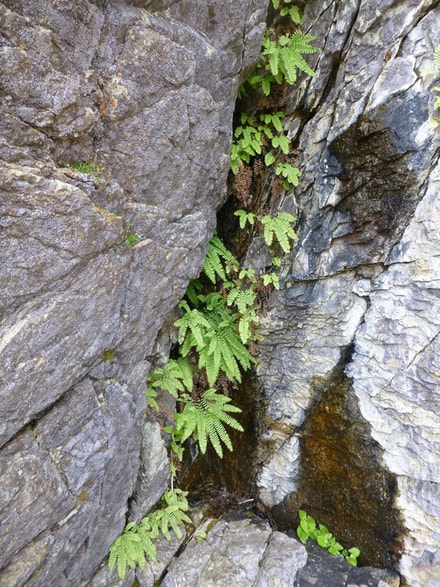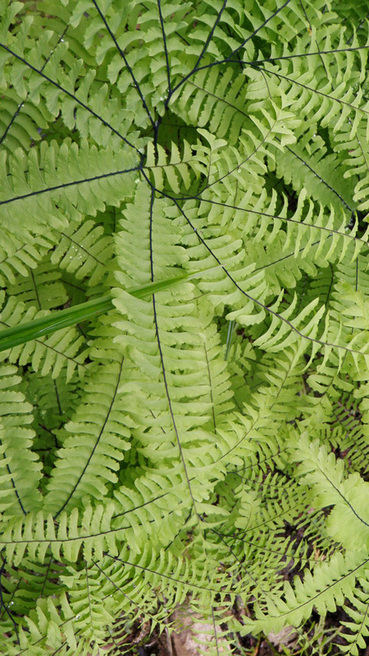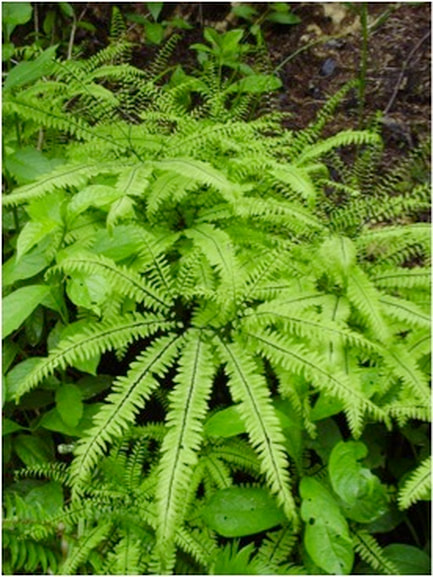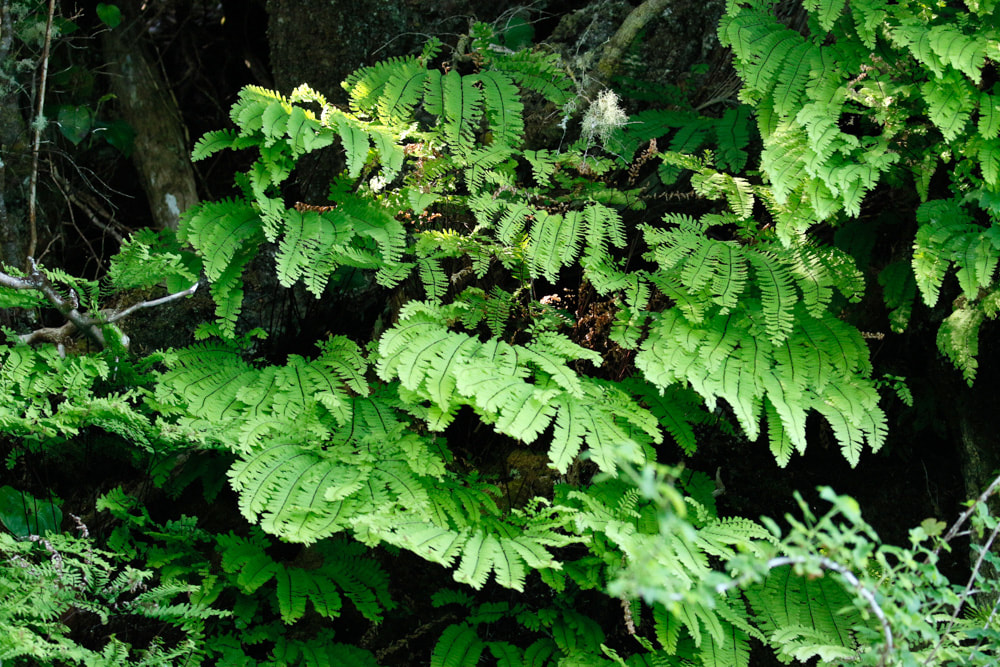Western maidenhair fern, Aleutian maidenhair • Adiantum aleuticum (formerly A. pedatum)
{Adiantum = unwetted}
Maidenhair fern growing in rocky seeps and moist forest habitat. Photos by, clockwise from bottom left: Caylie Boos, Ian Cruickshank, Chanda Turner, and John Reynolds.
Identification
Maidenhair fern is one of the more delicate-looking ferns found on the central coast. It is a deciduous perennial, and is palmately branched. Stalks are dark reddish brown or purple-black and 15-60 cm tall. The whole blade measures 10-40 cm across. Sori are oblong and are found on the edges of the end leaflets.
Habitat & Range
Maidenhair fern grows in moist, shady areas with humus-rich soils. It is commonly found in moist forests, rocky areas, and along streams and waterfalls. It usually grows at low to middle elevations, and can occasionally be found in subalpine areas. There are varying accounts of the range of this species. It is frequently found throughout BC, but is less common in the southern interior of the province. In the Pacific Northwest, its range extends from Alaska south to Oregon. It has also been reported in southwestern Alberta, and can be found in Quebec, Newfoundland and in the south-central United States.
Similar Species
Limestone maidenhair spleenwort has similar-looking fronds, but is not palmately branched.
Western maidenhair fern was once grouped together with the northern maidenhair fern A. pedatum, which is found in the eastern half of North America.
Human Uses
Traditional First Nations uses of maidenhair fern include as a medicine (the leaves) and for basketweaving (the stems). It was also once exported to Europe and used to make cough syrup, as well as a syrup called 'capillaire' which is described in this recipe. Capillaire also has some emetic qualities, meaning it can be used to induce vomiting.
Intriguing Info
The name "maidenhair" originated from another plant — a European bog species that young girls once used to turn their hair blonde. The genus name, Adiantum, meaning unwetted, is appropriate as the leaves wick rain.
iNaturalist
https://www.inaturalist.org/taxa/52667-Adiantum-aleuticum
Maidenhair fern is one of the more delicate-looking ferns found on the central coast. It is a deciduous perennial, and is palmately branched. Stalks are dark reddish brown or purple-black and 15-60 cm tall. The whole blade measures 10-40 cm across. Sori are oblong and are found on the edges of the end leaflets.
Habitat & Range
Maidenhair fern grows in moist, shady areas with humus-rich soils. It is commonly found in moist forests, rocky areas, and along streams and waterfalls. It usually grows at low to middle elevations, and can occasionally be found in subalpine areas. There are varying accounts of the range of this species. It is frequently found throughout BC, but is less common in the southern interior of the province. In the Pacific Northwest, its range extends from Alaska south to Oregon. It has also been reported in southwestern Alberta, and can be found in Quebec, Newfoundland and in the south-central United States.
Similar Species
Limestone maidenhair spleenwort has similar-looking fronds, but is not palmately branched.
Western maidenhair fern was once grouped together with the northern maidenhair fern A. pedatum, which is found in the eastern half of North America.
Human Uses
Traditional First Nations uses of maidenhair fern include as a medicine (the leaves) and for basketweaving (the stems). It was also once exported to Europe and used to make cough syrup, as well as a syrup called 'capillaire' which is described in this recipe. Capillaire also has some emetic qualities, meaning it can be used to induce vomiting.
Intriguing Info
The name "maidenhair" originated from another plant — a European bog species that young girls once used to turn their hair blonde. The genus name, Adiantum, meaning unwetted, is appropriate as the leaves wick rain.
iNaturalist
https://www.inaturalist.org/taxa/52667-Adiantum-aleuticum
References
Adiantum aleuticum (Rupr.) Paris. In Klinkenberg, Brian. (Editor) 2017. E-Flora BC: Electronic Atlas of the Plants of British Columbia [eflora.bc.ca]. Lab for Advanced Spatial Analysis, Department of Geography, University of British Columbia, Vancouver.
Adiantum aleuticum (Rupr.) Paris. USDA PLANTS profile. Accessed 03/04/2013.
Pojar, J. and MacKinnon, A. (1994). Plants of Coastal British Columbia, Revised. Vancouver, BC: Lone Pine Publishing. P. 425.
Authors and editors of page
Bea Proudfoot, Chanda Brietzke and Brian Starzomski (2013).
Adiantum aleuticum (Rupr.) Paris. In Klinkenberg, Brian. (Editor) 2017. E-Flora BC: Electronic Atlas of the Plants of British Columbia [eflora.bc.ca]. Lab for Advanced Spatial Analysis, Department of Geography, University of British Columbia, Vancouver.
Adiantum aleuticum (Rupr.) Paris. USDA PLANTS profile. Accessed 03/04/2013.
Pojar, J. and MacKinnon, A. (1994). Plants of Coastal British Columbia, Revised. Vancouver, BC: Lone Pine Publishing. P. 425.
Authors and editors of page
Bea Proudfoot, Chanda Brietzke and Brian Starzomski (2013).








